Function of RCP
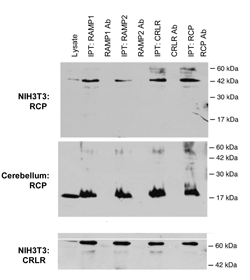
Figure 1A. RCP co-immunoprecipitated
with RAMP1 and CLR.
RCP co-immunoprecipitated with RAMP1 and CLR (Fig. 1A), suggesting that the functional CGRP receptor was a trimer of CLR/RAMP1/RCP proteins (Fig. 1B). RCP is highly conserved between species, yet does not contain obvious motifs that suggest how it might work to enable CGRP receptor function.
Furthermore, RCP is expressed in all immortalized cell lines we have examined, even in those that do not express CGRP receptors (Fig 2A) and in most tissue, making gain-of-function experiments difficult. Interestingly, when cells expressing CGRP receptors are examined, expression of RCP correlates with a higher cAMP response to CGRP, even if expression of CLR is decreased (Fig.2B), suggesting that RCP can regulate the ability of CLR to signal.
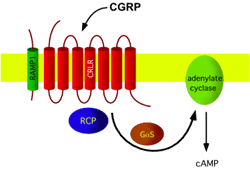
Figure 1B. The functional CGRP receptor was a
trimer of CLR/RAMP1/RCP proteins.
CGRP-mediated signal transduction directly, stable cell lines were made that expressed the antisense construct of RCP. In these cells RCP expression was depleted (Fig. 3), and CGRP-induced cAMP response was inhibited (Fig. 4). Interestingly, signaling by adrenomedullin (AM), a neuropeptide with homology to CGRP, was also inhibited in cells with depleted of RCP. CLR can bind AM when co-expressed with a second RAMP called RAMP2, and these antisense results suggest that RCP is required for AM receptor signaling as well as for CGRP. However, signaling by two other GPCRs (β2-adrenergic and adenosine PY2) were not affected by loss of RCP. Thus, RCP does not appear to be a generalized signaling protein, but is instead limited to a subset of GPCRs.
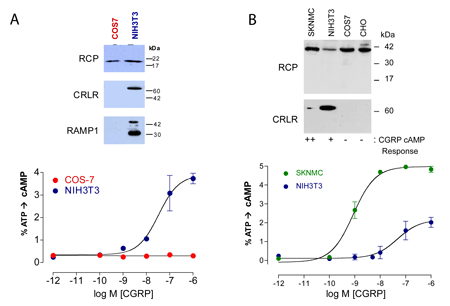
Figure 2. A. Cells with CGRP receptors express CRLR, RAMP1 and RCP; B.
RCP enhances CGRP-mediated signaling.
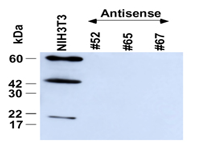
Figure 3. Antisense Cell Lines.
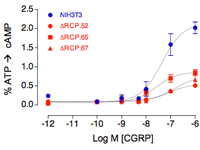
Figure 4. CGRP-induced cAMP
response was inhibited.
RCP in vivo: Contrary to our studies in immortalized cell lines, RCP expression in vivo was in discrete cell types, usually juxtaposed with CGRP-containing neurons (Fig. 5). RCP is also regulated in vivo, and expression of RCP correlates with efficacy of CGRP, suggesting that RCP can regulate function of the CGRP receptor complex. RCP thus represents a new level of regulation for GPCR signal transduction.

Figure 5. RCP is co-localized with CGRP in dorsal horn of spinal cord. Spinal cord
section stained with antibody against CGRP (green) or RCP (red), and merged image.
We discovered an intracellular protein required for activation of the CGRP receptor. The receptor for CGRP is an attractive target for development of therapeutics given the wide range. We also discovered that direct interaction between RCP and the second intracellular cytoplasmic loop of CLR is required for activation of CLR, and our lab is working on determining the mechanism and regulation of RCP on CLR signaling. Our laboratory is investigating the mechanism of RCP action by:
-
Determining the molecular and biochemical requirements for RCP function in cell culture using mutagenic strategies to identify functional domains in RCP.
-
Identifying proteins that interact with RCP in a functional receptor complex, using immunoprecipitation coupled with mass spectroscopy. We have identified several novel protein interactions that suggest that RCP has a more complex role in cellular physiology in addition to activating CLR.
-
Determining the role of RCP and CGRP in vivo using targeted homologous recombination.
« back to all projects